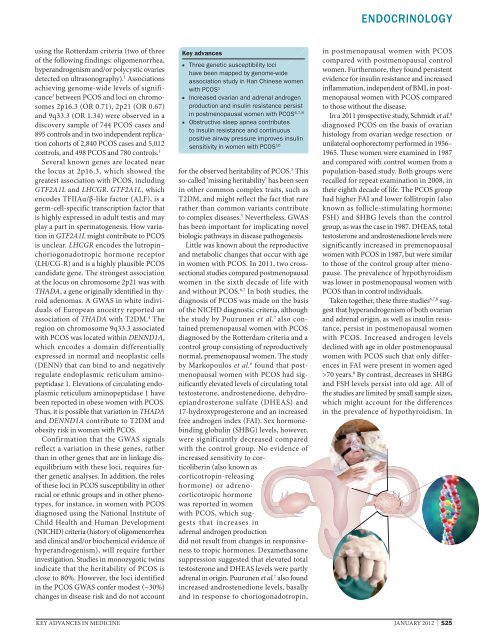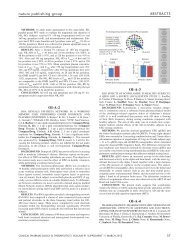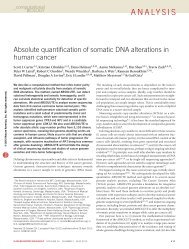open access: Nature Reviews: Key Advances in Medicine
open access: Nature Reviews: Key Advances in Medicine
open access: Nature Reviews: Key Advances in Medicine
Create successful ePaper yourself
Turn your PDF publications into a flip-book with our unique Google optimized e-Paper software.
us<strong>in</strong>g the Rotterdam cri teria (two of three<br />
of the follow<strong>in</strong>g f<strong>in</strong>d<strong>in</strong>gs: oligomenor rhea,<br />
hyperandrogen ism and/or poly cystic ovaries<br />
detected on ultrasono graphy). 1 Asso cia tions<br />
achiev <strong>in</strong>g genome-wide levels of significance<br />
3 between PCOS and loci on chromosomes<br />
2p16.3 (OR 0.71), 2p21 (OR 0.67)<br />
and 9q33.3 (OR 1.34) were observed <strong>in</strong> a<br />
dis covery sample of 744 PCOS cases and<br />
895 con trols and <strong>in</strong> two <strong>in</strong>depen dent replication<br />
cohorts of 2,840 PCOS cases and 5,012<br />
controls, and 498 PCOS and 780 controls. 1<br />
Several known genes are located near<br />
the locus at 2p16.3, which showed the<br />
great est association with PCOS, <strong>in</strong>clud <strong>in</strong>g<br />
GTF2A1L and LHCGR. GTF2A1L, which<br />
encodes TFIIAα/β-like factor (ALF), is a<br />
germ-cell-specific transcription factor that<br />
is highly expressed <strong>in</strong> adult testis and may<br />
play a part <strong>in</strong> spermato genesis. How variation<br />
<strong>in</strong> GTF2A1L might contribute to PCOS<br />
is unclear. LHCGR encodes the lutrop<strong>in</strong>–<br />
choriogonadotropic hormone recep tor<br />
(LH/CG-R) and is a highly plau si ble PCOS<br />
candidate gene. The strongest asso ci ation<br />
at the locus on chromo some 2p21 was with<br />
THADA, a gene origi nally iden tified <strong>in</strong> thy -<br />
roid adenomas. A GWAS <strong>in</strong> white <strong>in</strong>dividuals<br />
of European ances try reported an<br />
associa tion of THADA with T2DM. 4 The<br />
region on chromosome 9q33.3 associ ated<br />
with PCOS was located with<strong>in</strong> DENND1A,<br />
which encodes a doma<strong>in</strong> differen tially<br />
expressed <strong>in</strong> normal and neoplastic cells<br />
(DENN) that can b<strong>in</strong>d to and negatively<br />
regulate endo plasmic reticulum am<strong>in</strong>opeptidase<br />
1. Elevations of circulat<strong>in</strong>g endoplasmic<br />
reti culum am<strong>in</strong>o peptidase 1 have<br />
been reported <strong>in</strong> obese women with PCOS.<br />
Thus, it is possible that varia tion <strong>in</strong> THADA<br />
and DENND1A contribute to T2DM and<br />
obesity risk <strong>in</strong> women with PCOS.<br />
Confirmation that the GWAS signals<br />
reflect a variation <strong>in</strong> these genes, rather<br />
than <strong>in</strong> other genes that are <strong>in</strong> l<strong>in</strong>kage disequilibrium<br />
with these loci, requires further<br />
genetic analyses. In addition, the roles<br />
of these loci <strong>in</strong> PCOS suscepti bility <strong>in</strong> other<br />
racial or eth nic groups and <strong>in</strong> other phenotypes,<br />
for <strong>in</strong>stance, <strong>in</strong> women with PCOS<br />
diag nosed us<strong>in</strong>g the National Insti tute of<br />
Child Health and Human Develop ment<br />
(NICHD) criteria (history of oligo menorrhea<br />
and cl<strong>in</strong>ical and/or biochemi cal evidence of<br />
hyper androgenism), will require further<br />
<strong>in</strong>vestigation. Studies <strong>in</strong> monozygotic tw<strong>in</strong>s<br />
<strong>in</strong>dicate that the herit ability of PCOS is<br />
close to 80%. However, the loci identified<br />
<strong>in</strong> the PCOS GWAS confer modest (~30%)<br />
changes <strong>in</strong> disease risk and do not account<br />
<strong>Key</strong> advances<br />
■ Three genetic susceptibility loci<br />
have been mapped by genome-wide<br />
association study <strong>in</strong> Han Ch<strong>in</strong>ese women<br />
with PCOS 1<br />
■ Increased ovarian and adrenal androgen<br />
production and <strong>in</strong>sul<strong>in</strong> resistance persist<br />
<strong>in</strong> postmenopausal women with PCOS 6,7,8<br />
■ Obstructive sleep apnea contributes<br />
to <strong>in</strong>sul<strong>in</strong> resistance and cont<strong>in</strong>uous<br />
positive airway pressure improves <strong>in</strong>sul<strong>in</strong><br />
sensitivity <strong>in</strong> women with PCOS 10<br />
for the observed herit ability of PCOS. 5 This<br />
so-called ‘miss<strong>in</strong>g heritability’ has been seen<br />
<strong>in</strong> other common complex traits, such as<br />
T2DM, and might reflect the fact that rare<br />
rather than common variants contribute<br />
to complex diseases. 5 Nevertheless, GWAS<br />
has been important for implicat<strong>in</strong>g novel<br />
b iologic pathways <strong>in</strong> disease pathogenesis.<br />
Little was known about the reproductive<br />
and metabolic changes that occur with age<br />
<strong>in</strong> women with PCOS. In 2011, two crosssectional<br />
studies compared postmenopausal<br />
women <strong>in</strong> the sixth decade of life with<br />
and without PCOS. 6,7 In both studies, the<br />
diagnosis of PCOS was made on the basis<br />
of the NICHD diagnostic criteria, although<br />
the study by Puurunen et al. 7 also conta<strong>in</strong>ed<br />
premenopausal women with PCOS<br />
diagnosed by the Rotterdam criteria and a<br />
control group consist<strong>in</strong>g of reproductively<br />
normal, premenopausal women. The study<br />
by Markopoulos et al. 6 found that postmenopausal<br />
women with PCOS had significantly<br />
elevated levels of circulat<strong>in</strong>g total<br />
testosterone, androstenedione, dehydroepiandrosterone<br />
sulfate (DHEAS) and<br />
17-hydroxyprogesterone and an <strong>in</strong>creased<br />
free androgen <strong>in</strong>dex (FAI). Sex hormoneb<strong>in</strong>d<strong>in</strong>g<br />
globul<strong>in</strong> (SHBG) levels, how ever,<br />
were significantly decreased compared<br />
with the control group. No evidence of<br />
<strong>in</strong>creased sensitivity to corticoliber<strong>in</strong><br />
(also known as<br />
corticotrop<strong>in</strong>- releas<strong>in</strong>g<br />
hormone) or adrenocortico<br />
tro pic hormone<br />
was reported <strong>in</strong> women<br />
with PCOS, which suggests<br />
that <strong>in</strong>creases <strong>in</strong><br />
adrenal androgen production<br />
did not result from changes <strong>in</strong> responsiveness<br />
to tropic hor mones. Dexamethasone<br />
suppression sug gested that elevated total<br />
testosterone and DHEAS levels were partly<br />
adrenal <strong>in</strong> orig<strong>in</strong>. Puurunen et al. 7 also found<br />
<strong>in</strong>creased androstenedione levels, basally<br />
and <strong>in</strong> response to chorio gonado trop<strong>in</strong>,<br />
ENDOCRINOLOGY<br />
<strong>in</strong> postmenopausal women with PCOS<br />
compared with postmenopausal control<br />
women. Furthermore, they found persistent<br />
evidence for <strong>in</strong>sul<strong>in</strong> resistance and <strong>in</strong>creased<br />
<strong>in</strong>flammation, <strong>in</strong>dependent of BMI, <strong>in</strong> postmenopausal<br />
women with PCOS compared<br />
to those without the disease.<br />
In a 2011 prospective study, Schmidt et al. 8<br />
diagnosed PCOS on the basis of ovarian<br />
histology from ovarian wedge resec tion or<br />
unilateral oophorectomy per formed <strong>in</strong> 1956–<br />
1965. These women were exam<strong>in</strong>ed <strong>in</strong> 1987<br />
and compared with control women from a<br />
population-based study. Both groups were<br />
recalled for repeat exam<strong>in</strong>ation <strong>in</strong> 2008, <strong>in</strong><br />
their eighth decade of life. The PCOS group<br />
had higher FAI and lower follitrop<strong>in</strong> (also<br />
known as follicle-stimulat<strong>in</strong>g hormone;<br />
FSH) and SHBG levels than the control<br />
group, as was the case <strong>in</strong> 1987. DHEAS, total<br />
testo sterone and androstenedione levels were<br />
significantly <strong>in</strong>creased <strong>in</strong> premenopausal<br />
women with PCOS <strong>in</strong> 1987, but were similar<br />
to those of the control group after menopause.<br />
The prevalence of hypo thyroidism<br />
was lower <strong>in</strong> post menopausal women with<br />
PCOS than <strong>in</strong> control <strong>in</strong>dividuals.<br />
Taken together, these three studies 6,7,8 suggest<br />
that hyperandrogenism of both ova rian<br />
and adrenal orig<strong>in</strong>, as well as <strong>in</strong>sul<strong>in</strong> resistance,<br />
persist <strong>in</strong> postmenopausal women<br />
with PCOS. Increased androgen levels<br />
decl<strong>in</strong>ed with age <strong>in</strong> older post menopausal<br />
women with PCOS such that only differences<br />
<strong>in</strong> FAI were present <strong>in</strong> women aged<br />
>70 years. 8 By contrast, decreases <strong>in</strong> SHBG<br />
and FSH levels persist <strong>in</strong>to old age. All of<br />
the studies are limited by small sample sizes,<br />
which might account for the differences<br />
<strong>in</strong> the prevalence of hypothyroidism. In<br />
KEY ADVANCES IN MEDICINE JANUARY 2012 | S25








